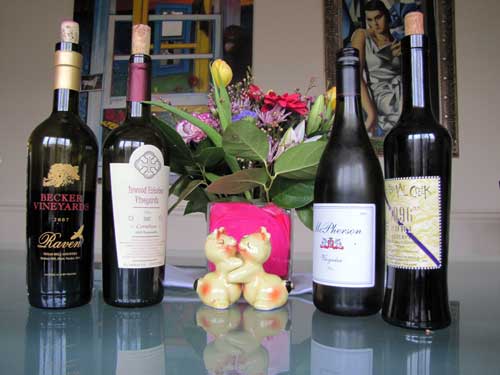
What Texas Wines do you Serve to Napa Valley Winegrowers?
Saturday evening, we hosted a wonderful dinner party for Chuck and Lisa Reid. They are long time friends and Texans that live in Houston this part of the year and then return to Napa Valley for the summer where they grow Cabernet Sauvignon at their Farmhouse Vineyard location on the Silverado Trail (https://vintagetexas.com/?p=56). Lisa is also an artist that shows her work online at: http://lisamreid.fineartstudioonline.com. The interesting question is….What Texas wines do you serve someone who is up close and personal with the fine wines that come from Napa Valley, California? Rather than try to be Napa, I though it better to be Texas and serve the wines that define Texas’ wine character.
After pondering the question for a while and I worked on my menu and then the wines to match. The pairings ended up to be the following:
Appetizer – Smoked olives served with a goat cheese/hummus spread combined with fresh chopped garlic (Becker Vineyards Raven – www.beckervineyards.com).
First Course – Corn and lemongrass soup steeped with Kaffir lime leaves and pureed with shrimp (McPherson Cellars Viognier – www.mcphersoncellars.com)
Main Course – Smoked Cornish game hens with chicken andouille sausage dirty rice and roasted asparagus with herbs d’ Provence and balsamic vinegar (Inwood Estates Vineyards Cornelious Tempranillo – www.inwoodwines.com)
Dessert – Chocolate Mousse, complements of Lisa Reid (Dry Comal Creek 1096 – www.drycomalcreek.com)
The two red wines that I selected, I experienced before and was impressed with both. They are intense red wines from Texas, but each having its own special character. The first was Becker Vineyards Raven. It is comprised of ninety percent Malbec and ten percent Petite Verdot from Drew Tallant’s Vineyard in the granitic sands just north of Mason Texas. The other wine was Inwood Estates Vineyards Cornelius Tempranillo featuring Texas High Plains (near Lubbock) fruit from both Inwood and from Newsom Vineyards (www.newsomvineyards.com) in Yoakum County Texas.
The Becker Raven was a deep dark yet medium bodied red wine offering a fresh fruit forward qualities of blackberries overlaid on plums and hint of tart beetroot, decidedly new world in character carried by a rush of crisp acidity. [Added note: Two days later, I tasted the remnant of the Becker Raven. It was much more open than at dinner with a richer taste and feel. This wine definitely needs heavy aeration or extended decanting before you can get the full enjoyment from this wine.]
The white wine selected as a pairing for the pungent corn/lemongrass soup was McPherson Viognier which yielded an aromatic citrus/stonefruit accompaniment to the soup. It lingered on the palate with a silky feel and elements of peach and a hint of ginger (as in the ginger ale experience without the sweetness).
In contrast to the Becker Raven, the Inwood Tempranillo provided a counterstatement in older world Rioja style with extended oak aging, intense dark color and thick body seen by eye and felt on the palate. Cherry, bramble, earth and bit of oaken vanilla provided grace and complexity.
The selection of the dessert wine actually came as more of an afterthought more than through a statement of advance planning. Previous that day, I was writing on my book project and was presenting the old wines of the Spanish missionaries and the wines of El Paso that were predominant in the commercial Texas wine industry through the end of the nineteen century. In my readings, I discovered descriptions of the techniques used and they were far from the reductive methods commonly used today. These wines of yore were likely of a distinct oxidized character from exposure to the elements during harvesting, aging and storage.
The Dry Comal Creek 1096 wine presented the highly oxidized winemaking style called Rancio (www.wein-plus.com/france_guide/Banyuls+AOC_B62.html) common to the Banyuls regions of the French Pyrenees as applied to the Texas Black Spanish (Lenoir) grape. It gets its name from the in-barrel exposure to the ambient Texas environment for a total of 1096 days that yielded a thick, intense and concentrated wine with a caramel, nutty character.
The comments from our guests were very complimentary for Texas wines. They were impressed with the deep dark qualities of the red wines from Texas and especially the contrast between them: Fresh and fruit forward and rich and old world earthy. The Viognier was not overblown with over ripe fruit, yielding a style that they agreed was the best. The Black Spanish 1096 was a real surprise for them, nothing like it from California, but Chuck remembered the rancio wine style from his race car days running through the steep hillside curves of southern France.


Wonderful wines and wonderful selections, Russ. Best yet, yhour sentiment — let Texas be Texas.
Really enjoyed this — looking forward to trying the Tempranillo! God bless Texas.
Thanks Jeff and Elizabeth for your interest and readership
Russ
Texas WineSlinger
Can anybody tell me what those creatures are in the photo between the wine bottles. They are salt and pepper shakers that my wife’s family had for over 60 years. Not rabbits and not bears, what are they?
Russ
Nice to see the Napa vintners not falling into the classic French trap of thinking that their wines are the correct ones and anyone not trying to copy them isn’t making good wine.
Variety is important in the industry and it would certainly be nice to find a great Tempranillo producer as that is one of the easiest wines to pair with given some of the classic Texan food choices.
The “inverse” of your comments are just as bad. Texans that think that wines aren’t good because they are not like those of California. I have seen that before.
Right now Tempranillo, Viognier and Blanc Du Bois are the leading Texas varietals.
Russ